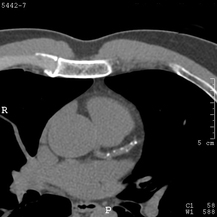 Assessment of patients with CT scans of the heart is becoming more common. A CT scan can detect the earliest signs of coronary artery disease which manifest itself as calcification and remodelling of the arteries before any stenosis or symptom develops and way before it can be detected by exercise treadmill or other functional tests. When patients are found to have moderate coronary artery disease or coronary calcification detected on a CT they are offered treatment with intensive risk factor modification with aspirin, statins and ACE inhibitors. Usually they ask two questions. First will these treatments reverse the coronary artery disease and second how can they monitor the situation going forward to find out if the treatment is working beyond simple measures like the absence of symptoms or change in cholesterol levels. Traditionally repeating the CT scan after a time interval has not been recommended however a recent paper from the MESA study group has questioned this. They looked at the value of repeat cardiac CT scanning to detect changes in coronary artery calcification (CAC) and to see if this was associated with increased risk of cardiac events such as heart attack. They studied 5,682 people with a baseline and follow-up CAC 2.5 years later. The results showed an annual increase in CAC score of about 25. In people with a CAC of 0 at baseline a 5-unit annual increase was associated with a 1.5 fold increase in risk of heart attack. In those people with a raised calcium score at baseline, for every 100 annual increase there was a 1.3 fold increase in risk. In those people with an annual progression of more than 300 there was a 6.3 fold increase in risk. So progression of CAC is associated with an increase risk of adverse outcomes for patients and monitoring progression of disease with a CT scan after an interval of about 2.5 years is a reasonable strategy. If progression is <100 then the patient can be reassured that their treatment is working and there risk is not increasing. If there is progression of >300 then they might benefit from a more intense treatment program.
0 Comments
Your comment will be posted after it is approved.
Leave a Reply. |
Dr Richard BogleThe opinions expressed in this blog are strictly those of the author and should not be construed as the opinion or policy of my employers nor recommendations for your care or anyone else's. Always seek professional guidance instead. Archives
August 2023
Categories
All
|
 RSS Feed
RSS Feed

